Seismic Refraction Exploration for Groundwater Potential Evaluations: A Case Study of Vientiane Province, Laos
Recently, there has been increased interest in the use of seismic refraction surveys for the
exploration of groundwater investigations. The aim of this study is to delineate groundwater
potential zones using the seismic refraction technique. SmartSeis ST, with 12 channels seismograph
was selected for seismic refraction data acquisition in Phonhong district of Vientiane Province, Laos.
The seismic velocities distribution analysis indicated that there are three different subsurface
lithological zones ranging between (300–750m/s), (700–1650m/s), and (1500–2100m/s). Gradual
increase of seismic velocity indicates changes of lithological layers with vertical depth. This velocity
increase is due to the dense lithological formation which changes vertically deep from alluvial
sediments to dry sand and then to siltstone and gravel layers according to the borehole data. The
seismic refraction results show that the aquifer is a sand and gravel aquifer with a thickness of
unclear. The depth to the groundwater saturated layers ranging from 10 m to 25 m. The results of
this study have indicated that the application of the seismic refraction exploration method to find
groundwater is feasible and effective and can delineate groundwater potential zones in Laos.
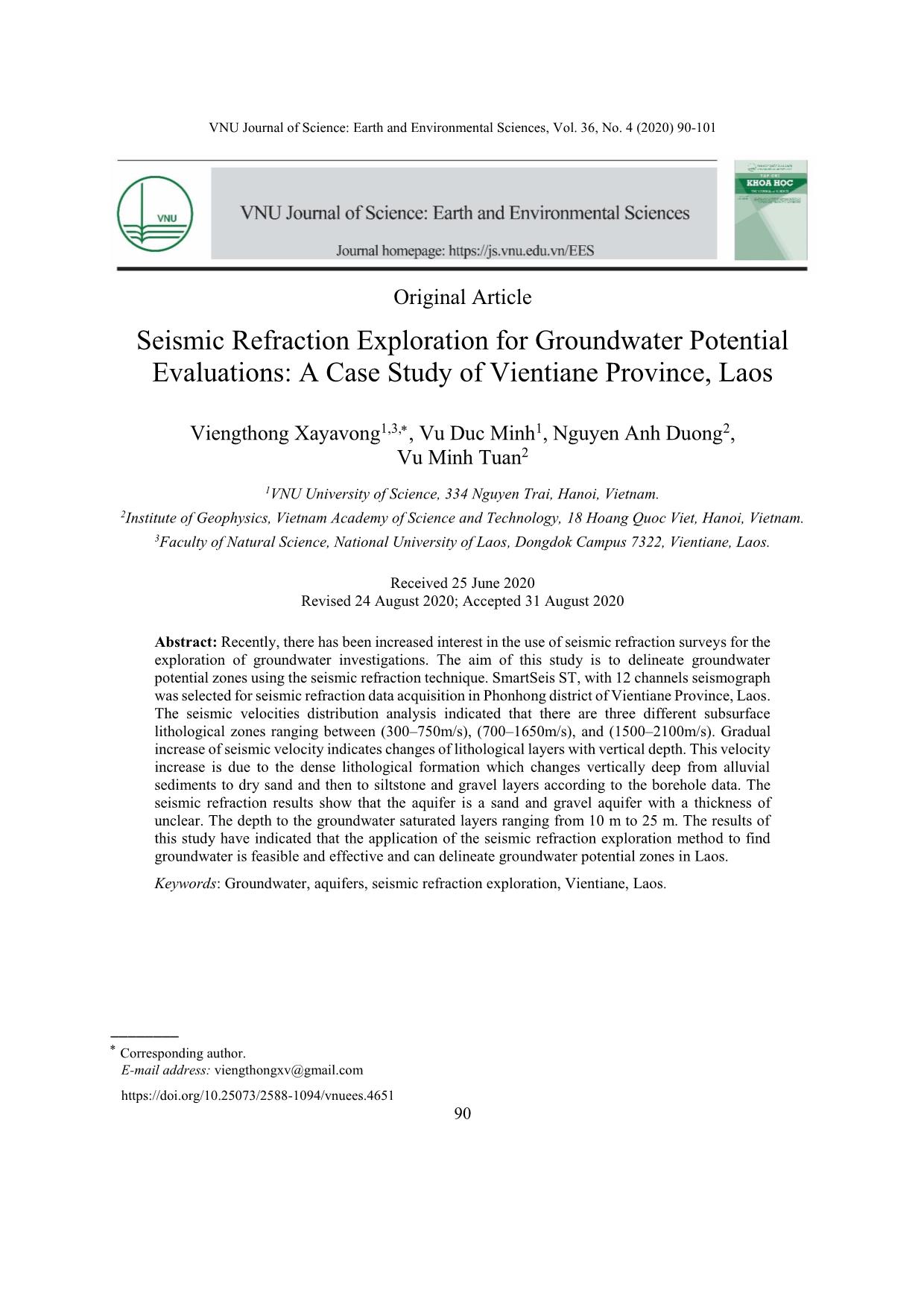
Trang 1
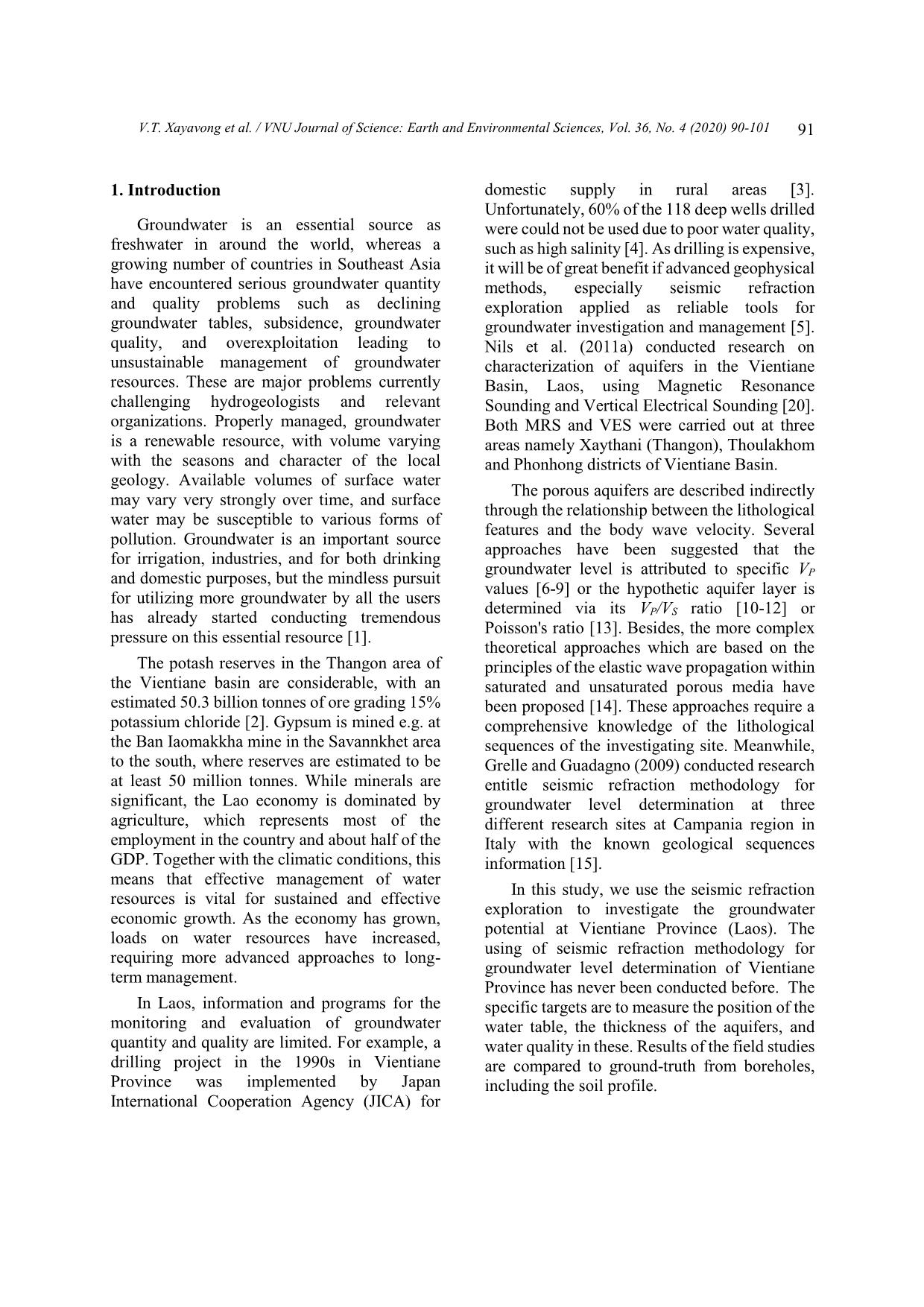
Trang 2
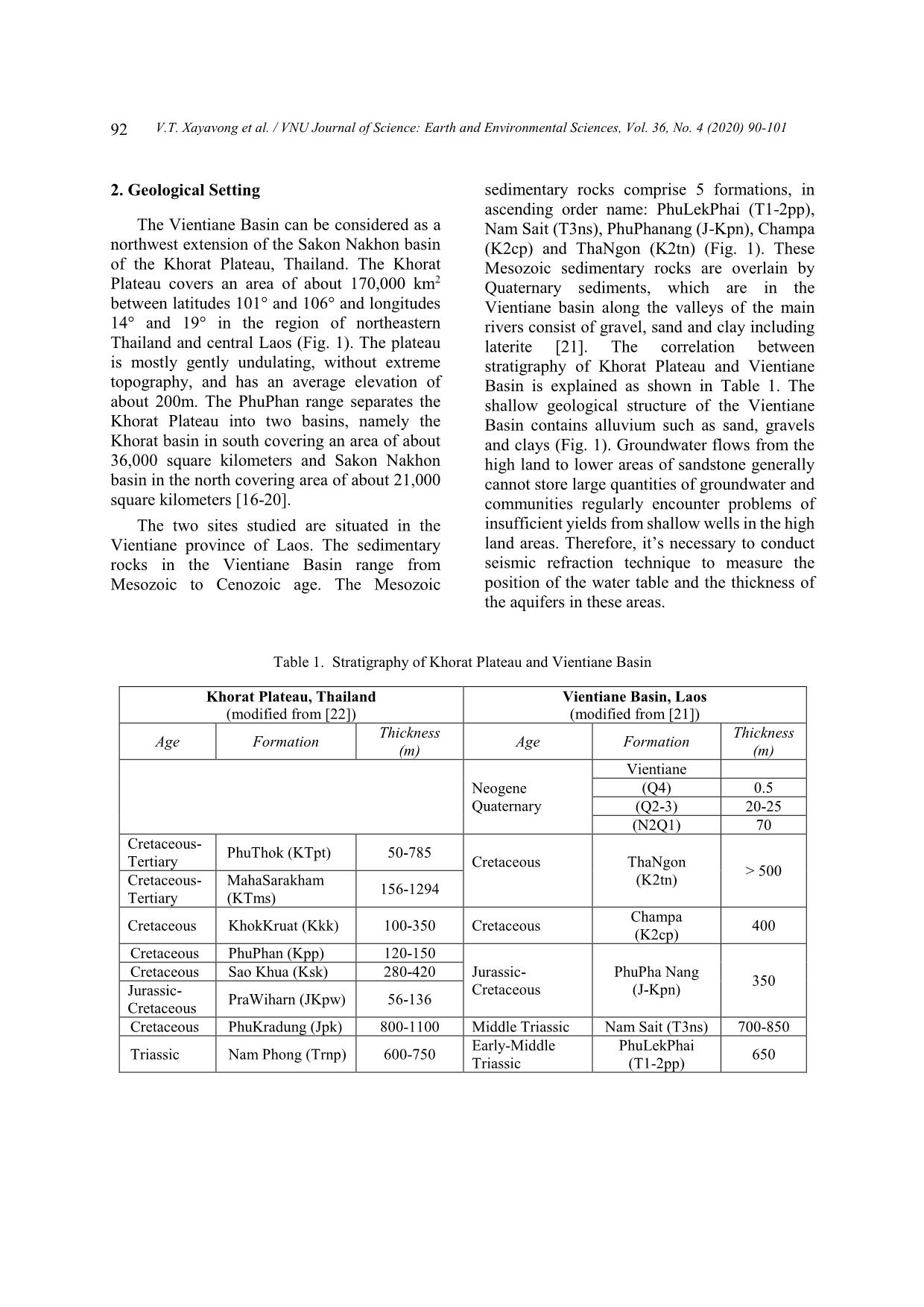
Trang 3
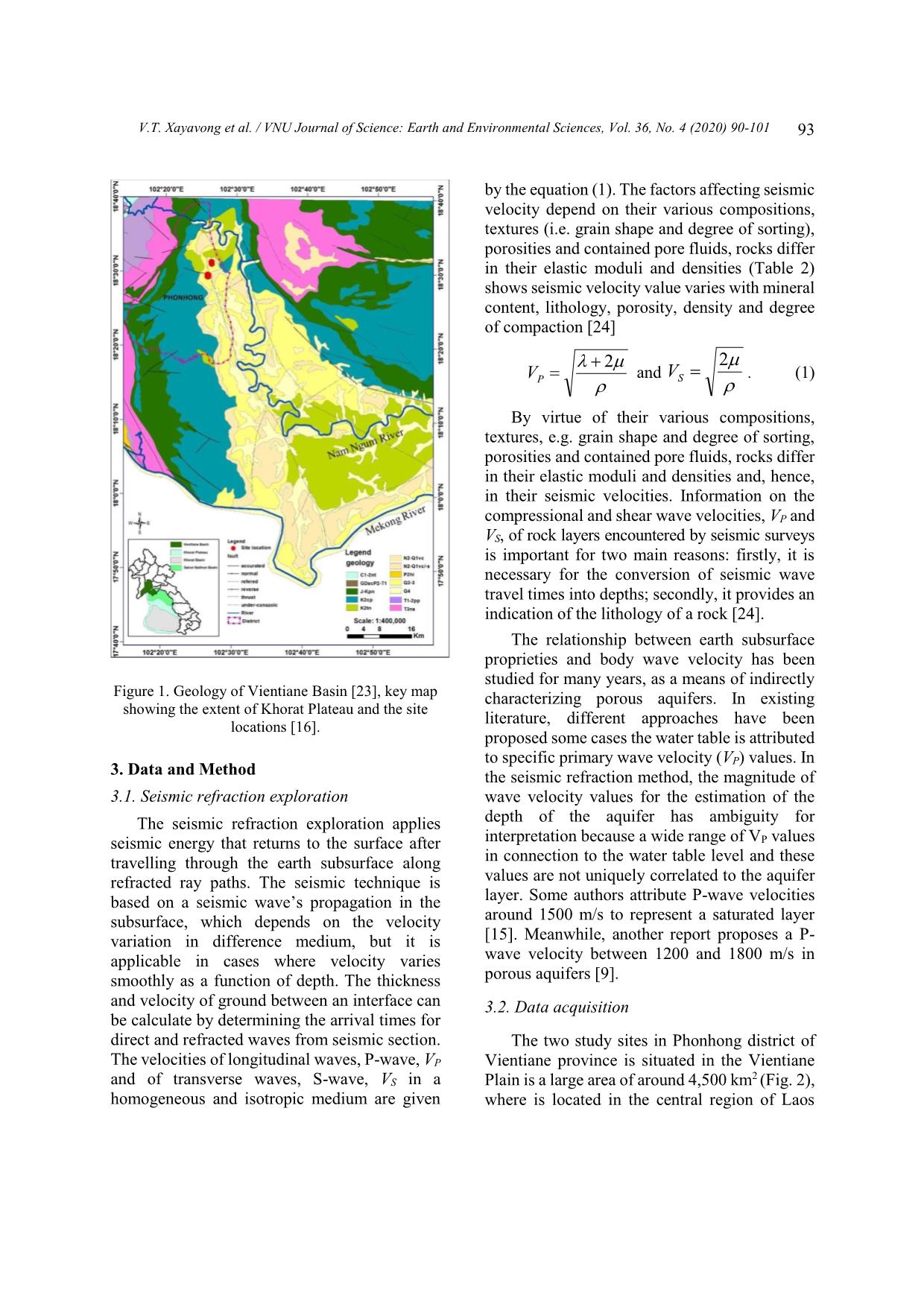
Trang 4
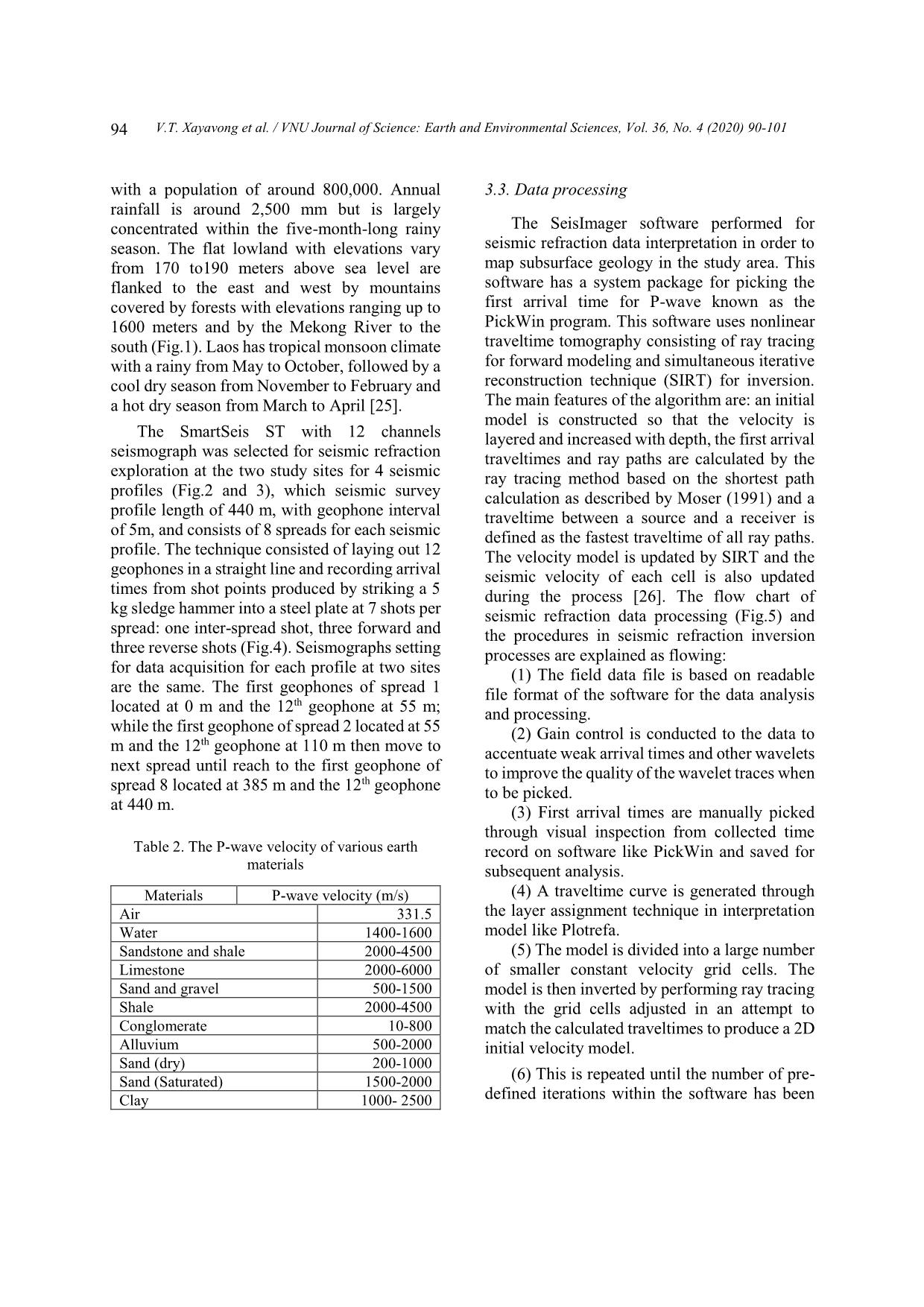
Trang 5
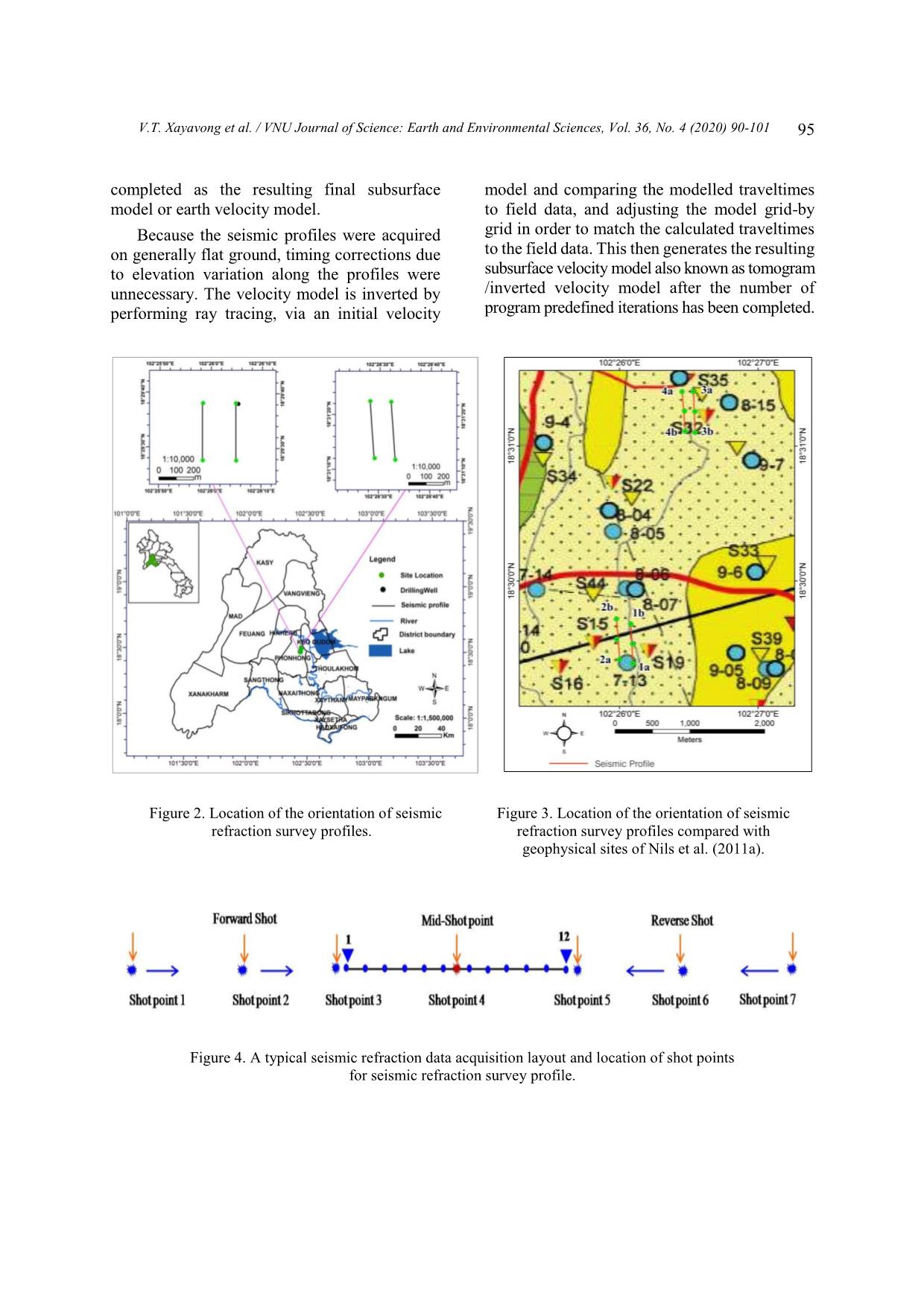
Trang 6
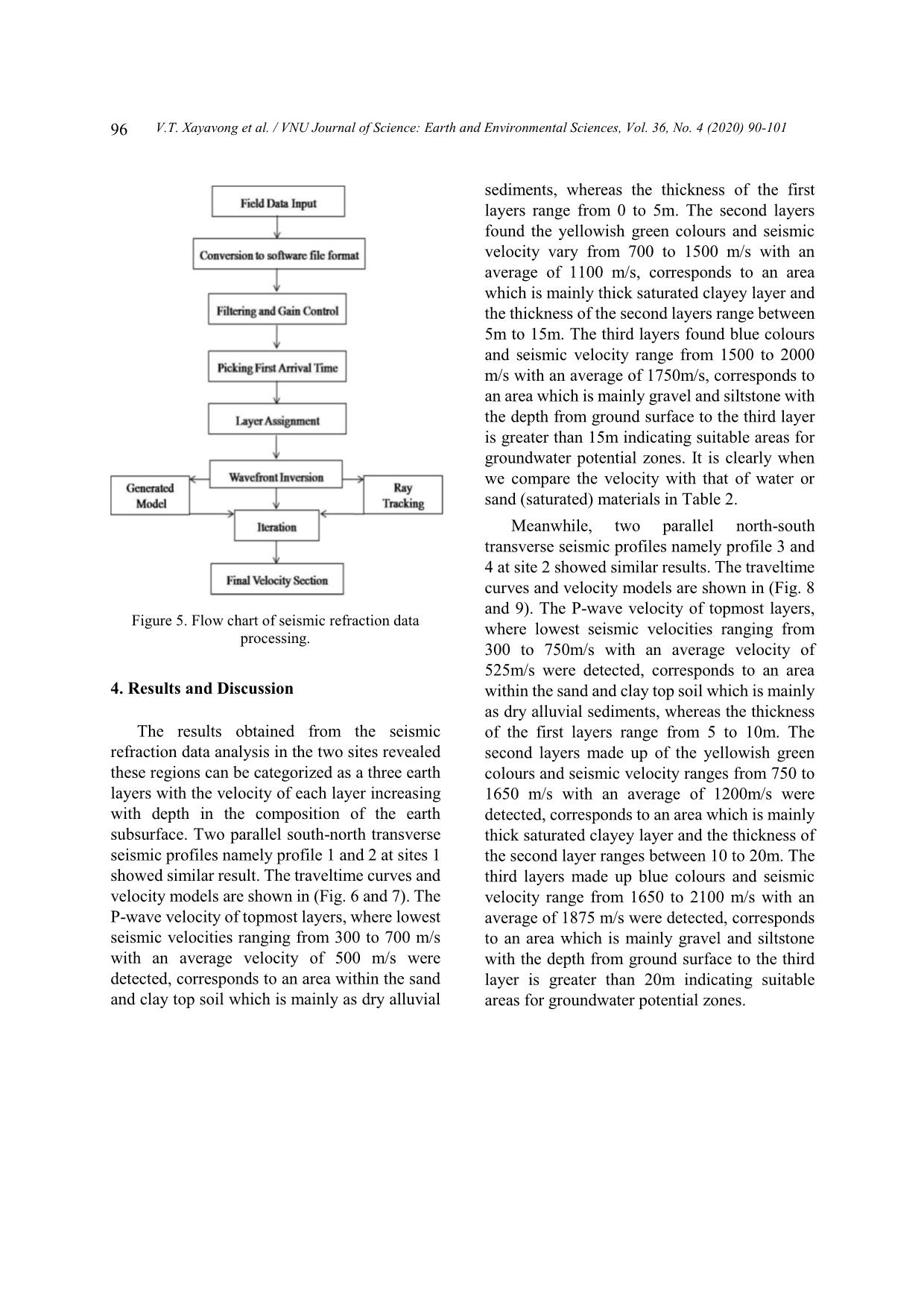
Trang 7
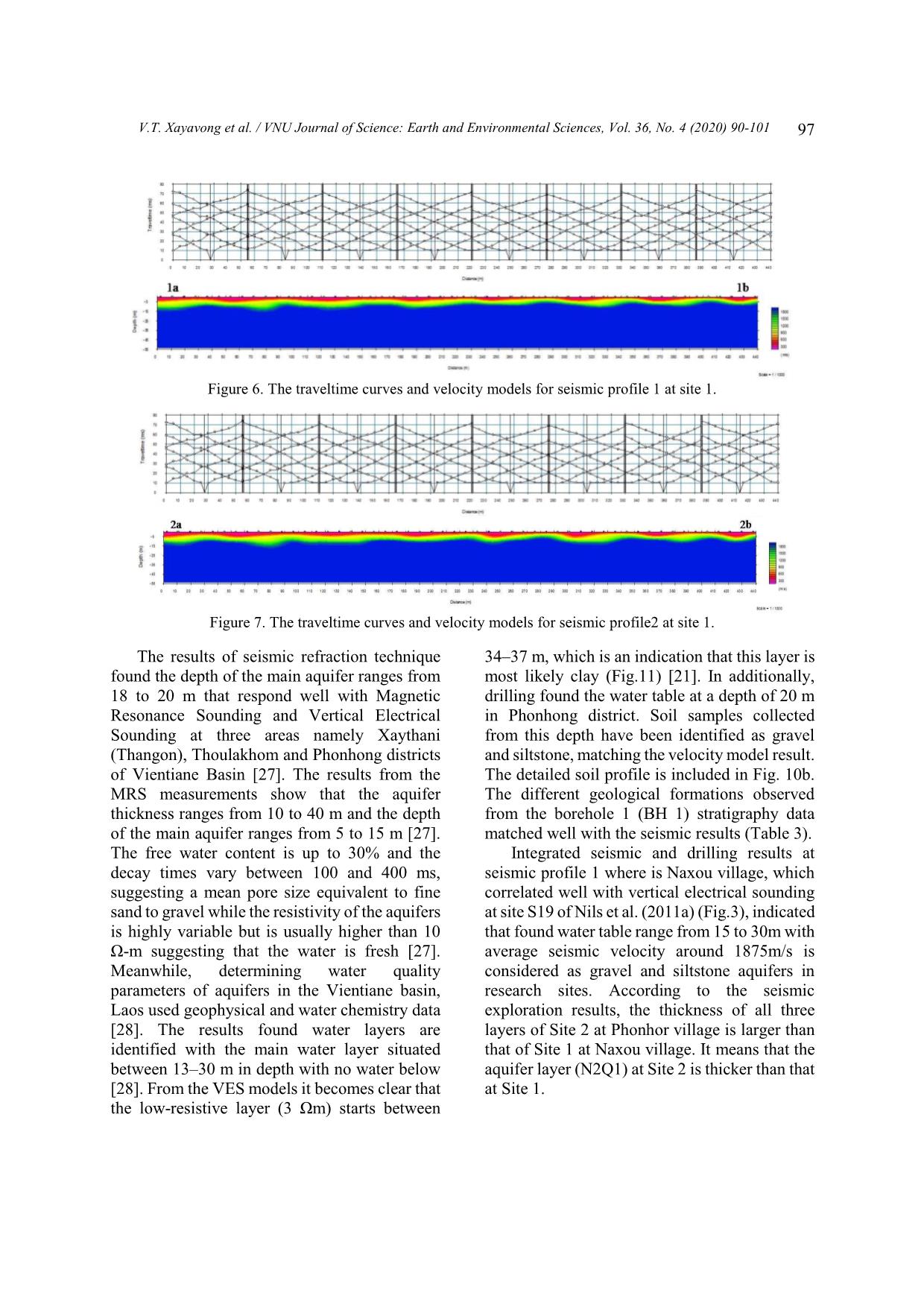
Trang 8
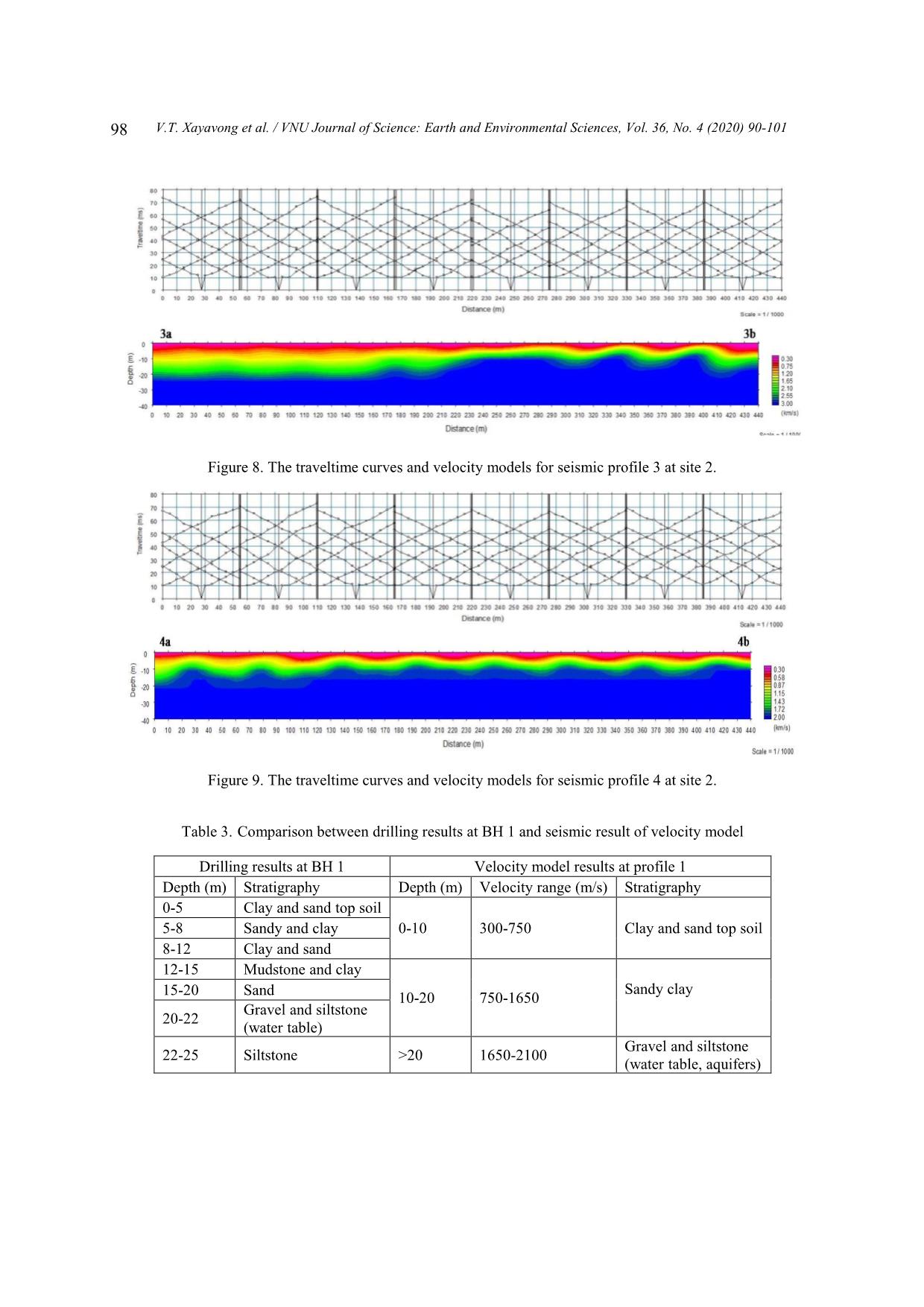
Trang 9
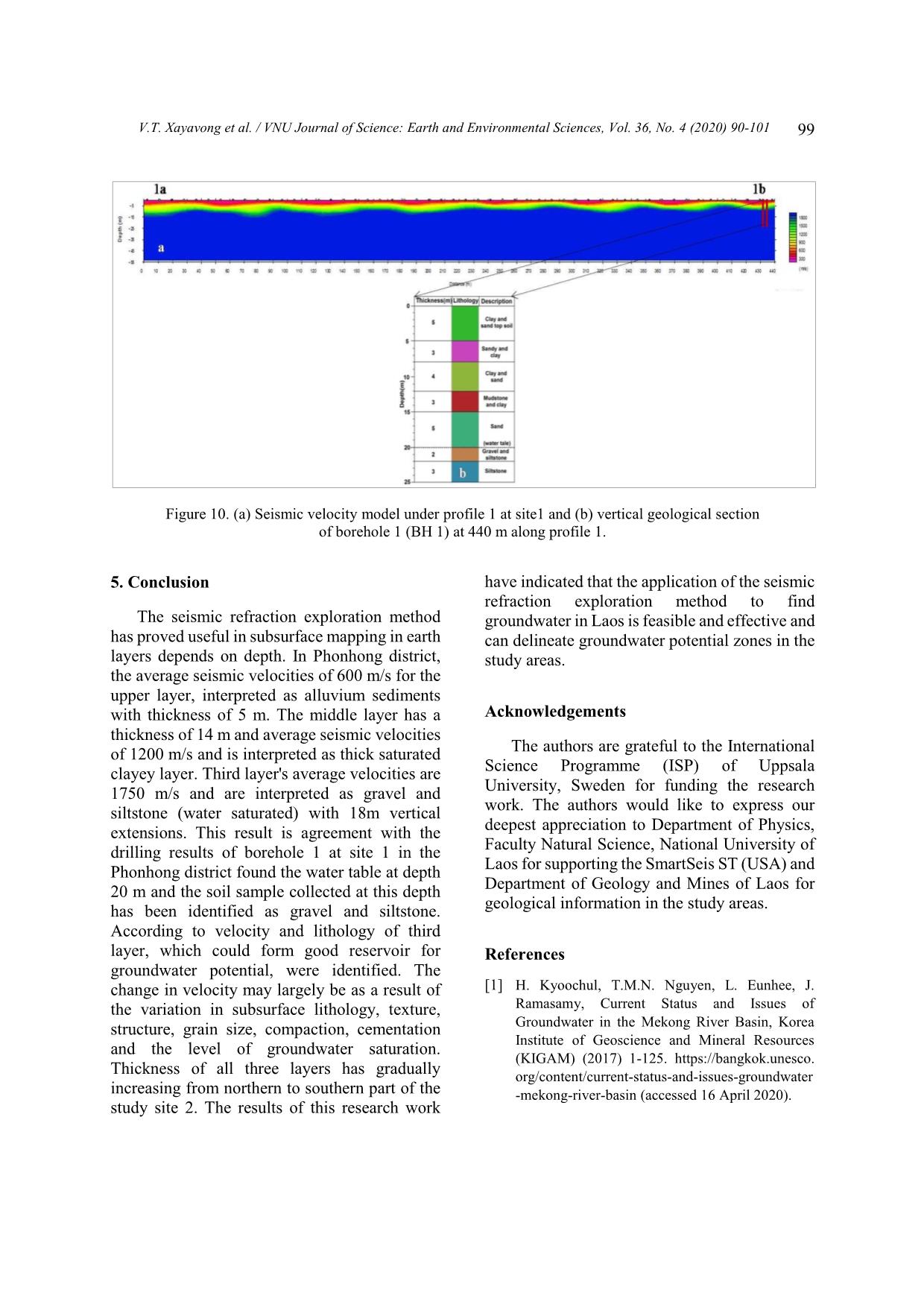
Trang 10
Tải về để xem bản đầy đủ
Tóm tắt nội dung tài liệu: Seismic Refraction Exploration for Groundwater Potential Evaluations: A Case Study of Vientiane Province, Laos
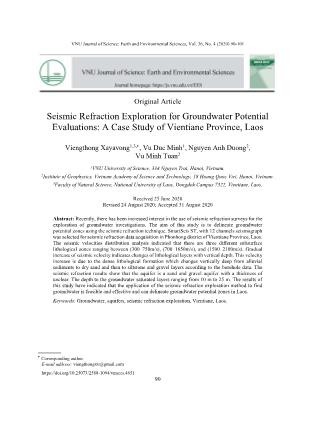
VNU Journal of Science: Earth and Environmental Sciences, Vol. 36, No. 4 (2020) 90-101 90 Original Article Seismic Refraction Exploration for Groundwater Potential Evaluations: A Case Study of Vientiane Province, Laos Viengthong Xayavong1,3, , Vu Duc Minh1, Nguyen Anh Duong2, Vu Minh Tuan2 1VNU University of Science, 334 Nguyen Trai, Hanoi, Vietnam. 2Institute of Geophysics, Vietnam Academy of Science and Technology, 18 Hoang Quoc Viet, Hanoi, Vietnam. 3Faculty of Natural Science, National University of Laos, Dongdok Campus 7322, Vientiane, Laos. Received 25 June 2020 Revised 24 August 2020; Accepted 31 August 2020 Abstract: Recently, there has been increased interest in the use of seismic refraction surveys for the exploration of groundwater investigations. The aim of this study is to delineate groundwater potential zones using the seismic refraction technique. SmartSeis ST, with 12 channels seismograph was selected for seismic refraction data acquisition in Phonhong district of Vientiane Province, Laos. The seismic velocities distribution analysis indicated that there are three different subsurface lithological zones ranging between (300–750m/s), (700–1650m/s), and (1500–2100m/s). Gradual increase of seismic velocity indicates changes of lithological layers with vertical depth. This velocity increase is due to the dense lithological formation which changes vertically deep from alluvial sediments to dry sand and then to siltstone and gravel layers according to the borehole data. The seismic refraction results show that the aquifer is a sand and gravel aquifer with a thickness of unclear. The depth to the groundwater saturated layers ranging from 10 m to 25 m. The results of this study have indicated that the application of the seismic refraction exploration method to find groundwater is feasible and effective and can delineate groundwater potential zones in Laos. Keywords: Groundwater, aquifers, seismic refraction exploration, Vientiane, Laos. ________ Corresponding author. E-mail address: viengthongxv@gmail.com https://doi.org/10.25073/2588-1094/vnuees.4651 V.T. Xayavong et al. / VNU Journal of Science: Earth and Environmental Sciences, Vol. 36, No. 4 (2020) 90-101 91 1. Introduction Groundwater is an essential source as freshwater in around the world, whereas a growing number of countries in Southeast Asia have encountered serious groundwater quantity and quality problems such as declining groundwater tables, subsidence, groundwater quality, and overexploitation leading to unsustainable management of groundwater resources. These are major problems currently challenging hydrogeologists and relevant organizations. Properly managed, groundwater is a renewable resource, with volume varying with the seasons and character of the local geology. Available volumes of surface water may vary very strongly over time, and surface water may be susceptible to various forms of pollution. Groundwater is an important source for irrigation, industries, and for both drinking and domestic purposes, but the mindless pursuit for utilizing more groundwater by all the users has already started conducting tremendous pressure on this essential resource [1]. The potash reserves in the Thangon area of the Vientiane basin are considerable, with an estimated 50.3 billion tonnes of ore grading 15% potassium chloride [2]. Gypsum is mined e.g. at the Ban Iaomakkha mine in the Savannkhet area to the south, where reserves are estimated to be at least 50 million tonnes. While minerals are significant, the Lao economy is dominated by agriculture, which represents most of the employment in the country and about half of the GDP. Together with the climatic conditions, this means that effective management of water resources is vital for sustained and effective economic growth. As the economy has grown, loads on water resources have increased, requiring more advanced approaches to long- term management. In Laos, information and programs for the monitoring and evaluation of groundwater quantity and quality are limited. For example, a drilling project in the 1990s in Vientiane Province was implemented by Japan International Cooperation Agency (JICA) for domestic supply in rural areas [3]. Unfortunately, 60% of the 118 deep wells drilled were could not be used due to poor water quality, such as high salinity [4]. As drilling is expensive, it will be of great benefit if advanced geophysical methods, especially seismic refraction exploration applied as reliable tools for groundwater investigation and management [5]. Nils et al. (2011a) conducted research on characterization of aquifers in the Vientiane Basin, Laos, using Magnetic Resonance Sounding and Vertical Electrical Sounding [20]. Both MRS and VES were carried out at three areas namely Xaythani (Thangon), Thoulakhom and Phonhong districts of Vientiane Basin. The porous aquifers are described indirectly through the relationship between the lithological features and the body wave velocity. Several approaches have been suggested that the groundwater level is attributed to specific VP values [6-9] or the hypothetic aquifer layer is determined via its VP/VS ratio [10-12] or Poisson's ratio [13]. Besides, the more complex theoretical approaches which are based on the principles of the elastic wave propagation within saturated and unsaturated porous media have been proposed [14]. These approaches require a comprehensive knowledge of the lithological sequences of the investigating site. Meanwhile, Grelle and Guadagno (2009) conducted research entitle seismic refraction methodology for groundwater level determination at three different research sites at Campania region in Italy with the known geological sequences information [15]. In this study, we use the seismi ... layers found blue colours and seismic velocity range from 1500 to 2000 m/s with an average of 1750m/s, corresponds to an area which is mainly gravel and siltstone with the depth from ground surface to the third layer is greater than 15m indicating suitable areas for groundwater potential zones. It is clearly when we compare the velocity with that of water or sand (saturated) materials in Table 2. Meanwhile, two parallel north-south transverse seismic profiles namely profile 3 and 4 at site 2 showed similar results. The traveltime curves and velocity models are shown in (Fig. 8 and 9). The P-wave velocity of topmost layers, where lowest seismic velocities ranging from 300 to 750m/s with an average velocity of 525m/s were detected, corresponds to an area within the sand and clay top soil which is mainly as dry alluvial sediments, whereas the thickness of the first layers range from 5 to 10m. The second layers made up of the yellowish green colours and seismic velocity ranges from 750 to 1650 m/s with an average of 1200m/s were detected, corresponds to an area which is mainly thick saturated clayey layer and the thickness of the second layer ranges between 10 to 20m. The third layers made up blue colours and seismic velocity range from 1650 to 2100 m/s with an average of 1875 m/s were detected, corresponds to an area which is mainly gravel and siltstone with the depth from ground surface to the third layer is greater than 20m indicating suitable areas for groundwater potential zones. V.T. Xayavong et al. / VNU Journal of Science: Earth and Environmental Sciences, Vol. 36, No. 4 (2020) 90-101 97 Figure 6. The traveltime curves and velocity models for seismic profile 1 at site 1. Figure 7. The traveltime curves and velocity models for seismic profile2 at site 1. The results of seismic refraction technique found the depth of the main aquifer ranges from 18 to 20 m that respond well with Magnetic Resonance Sounding and Vertical Electrical Sounding at three areas namely Xaythani (Thangon), Thoulakhom and Phonhong districts of Vientiane Basin [27]. The results from the MRS measurements show that the aquifer thickness ranges from 10 to 40 m and the depth of the main aquifer ranges from 5 to 15 m [27]. The free water content is up to 30% and the decay times vary between 100 and 400 ms, suggesting a mean pore size equivalent to fine sand to gravel while the resistivity of the aquifers is highly variable but is usually higher than 10 Ω-m suggesting that the water is fresh [27]. Meanwhile, determining water quality parameters of aquifers in the Vientiane basin, Laos used geophysical and water chemistry data [28]. The results found water layers are identified with the main water layer situated between 13–30 m in depth with no water below [28]. From the VES models it becomes clear that the low-resistive layer (3 Ωm) starts between 34–37 m, which is an indication that this layer is most likely clay (Fig.11) [21]. In additionally, drilling found the water table at a depth of 20 m in Phonhong district. Soil samples collected from this depth have been identified as gravel and siltstone, matching the velocity model result. The detailed soil profile is included in Fig. 10b. The different geological formations observed from the borehole 1 (BH 1) stratigraphy data matched well with the seismic results (Table 3). Integrated seismic and drilling results at seismic profile 1 where is Naxou village, which correlated well with vertical electrical sounding at site S19 of Nils et al. (2011a) (Fig.3), indicated that found water table range from 15 to 30m with average seismic velocity around 1875m/s is considered as gravel and siltstone aquifers in research sites. According to the seismic exploration results, the thickness of all three layers of Site 2 at Phonhor village is larger than that of Site 1 at Naxou village. It means that the aquifer layer (N2Q1) at Site 2 is thicker than that at Site 1. V.T. Xayavong et al. / VNU Journal of Science: Earth and Environmental Sciences, Vol. 36, No. 4 (2020) 90-101 98 Figure 8. The traveltime curves and velocity models for seismic profile 3 at site 2. Figure 9. The traveltime curves and velocity models for seismic profile 4 at site 2. Table 3. Comparison between drilling results at BH 1 and seismic result of velocity model Drilling results at BH 1 Velocity model results at profile 1 Depth (m) Stratigraphy Depth (m) Velocity range (m/s) Stratigraphy 0-5 Clay and sand top soil 0-10 300-750 Clay and sand top soil 5-8 Sandy and clay 8-12 Clay and sand 12-15 Mudstone and clay 10-20 750-1650 Sandy clay 15-20 Sand 20-22 Gravel and siltstone (water table) 22-25 Siltstone >20 1650-2100 Gravel and siltstone (water table, aquifers) V.T. Xayavong et al. / VNU Journal of Science: Earth and Environmental Sciences, Vol. 36, No. 4 (2020) 90-101 99 Figure 10. (a) Seismic velocity model under profile 1 at site1 and (b) vertical geological section of borehole 1 (BH 1) at 440 m along profile 1. 5. Conclusion The seismic refraction exploration method has proved useful in subsurface mapping in earth layers depends on depth. In Phonhong district, the average seismic velocities of 600 m/s for the upper layer, interpreted as alluvium sediments with thickness of 5 m. The middle layer has a thickness of 14 m and average seismic velocities of 1200 m/s and is interpreted as thick saturated clayey layer. Third layer's average velocities are 1750 m/s and are interpreted as gravel and siltstone (water saturated) with 18m vertical extensions. This result is agreement with the drilling results of borehole 1 at site 1 in the Phonhong district found the water table at depth 20 m and the soil sample collected at this depth has been identified as gravel and siltstone. According to velocity and lithology of third layer, which could form good reservoir for groundwater potential, were identified. The change in velocity may largely be as a result of the variation in subsurface lithology, texture, structure, grain size, compaction, cementation and the level of groundwater saturation. Thickness of all three layers has gradually increasing from northern to southern part of the study site 2. The results of this research work have indicated that the application of the seismic refraction exploration method to find groundwater in Laos is feasible and effective and can delineate groundwater potential zones in the study areas. Acknowledgements The authors are grateful to the International Science Programme (ISP) of Uppsala University, Sweden for funding the research work. The authors would like to express our deepest appreciation to Department of Physics, Faculty Natural Science, National University of Laos for supporting the SmartSeis ST (USA) and Department of Geology and Mines of Laos for geological information in the study areas. References [1] H. Kyoochul, T.M.N. Nguyen, L. Eunhee, J. Ramasamy, Current Status and Issues of Groundwater in the Mekong River Basin, Korea Institute of Geoscience and Mineral Resources (KIGAM) (2017) 1-125. https://bangkok.unesco. org/content/current-status-and-issues-groundwater -mekong-river-basin (accessed 16 April 2020). V.T. Xayavong et al. / VNU Journal of Science: Earth and Environmental Sciences, Vol. 36, No. 4 (2020) 90-101 100 [2] M. Masaharu, Final Report for Economic Geology, the World Bank Washington DC (2006). [3] Japan International Cooperation Agency (JICA). The study on rural water supply and sanitation improvement in the northwest region in the Lao People's Democratic Republic, Ministry of health, National centre for environmental health and water supply, Progress report 2 (2000) 14. [4] K. Takayanagi, Basic Design Study Report on the Project for Groundwater Development in Vientiane Province in Laos PDR, Japan International Cooperation Agency (JICA) (1993). [5] C. Chiemeke, and Aboh, Delineation of aquiferous layers within the basement complex using joint inversion of seismic refraction tomography and high resolution 3D seismic reflection survey, Arch. Applied Sci. Res 4 (2012) 400-405. https://www. researchgate.net/publication/282768427_Delineati on_of_aquiferous_layers_within_the_basement_c omplex_using_joint_inversion_of_seismic_refract ion_tomography_and_high_resolution_3D_seismi c_reflection_survey (accessed 16 April 2020). [6] A.A.R Zohdy, G.P. Eaton, D.R. Mabey,1974. Application of surface geophysics to groundwater investigation. U.S. Geol. Surv. Techniques of Water - Resource Investi- gations, book 2, chapter D1. [7] J.E. Sander, The blind zone in seismic ground- water exploration, Ground Water 165 (1978) 394- 395. https://doi.org/10.1111/j.1745-6584.1978.tb0 3252.x [8] F.P. Haeni, Application of seismic refraction methods in groundwater modelling studies in New England. Geophysics 51 (2) (1986) 236-249. http:// dx.doi.org/10.1190/1.1442083. [9] B. Hasselstroem, Water prospecting and rock- investigation by the seismic refraction method. Geoexploration 7 (2) (1969) 213. https://doi.org/ 10.1016/0016-7142(69)90026-X. [10] H. Stümpel, S. Kähler, R. Meissner, B. Milkereit, The use of seismic shear waves and compressional waves for lithological problems of shallow sediments. Geophysical Prospecting 32 (1984) 662-675. https://doi.org/10.1111/j.1365-2478. 1984.tb01712.x. [11] J.P. Castagna, M.L. Batzle, R.L. Eastwood, Relationship between compressional-wave and shear-wave velocities in clastic silicate rocks. Geophysics 50 (4) (1985) 571-581. https://doi.org/ 10.1190/1.1894108. [12] C. Nicholson, D.W. Simposon, Changes in VP/VS with depth: implication for appropriate velocity models, improved earthquake locations, and material proper- ties of the upper crust. Bulletin of the Seismological Society of America 75 (1985) 1105-1124. https://pubs.geoscienceworld.org/ssa/ bssa/article-abstract/75/4/1105/118773/Changes- in-Vp-Vs-with-depth-Implications-for?redirected From=fulltext (accessed 16 April 2020). [13] J.M. Lees, H. Wu, Poisson's ratio and porosity at Coso geothermal area, California. Journal of volcanology and geothermal research 95 (2000) 157-173. https://doi.org/10.1016/S0377-0273(99) 00126-2. [14] S. Foti, C.G. Lai, R. Lancellotta, Porosity of fluid- saturated porous media from measured seismic wave velocities. Geotechnique 52 (5) (2002), 359- 373. [15] G. Grelle, F.M. Guadagno, Seismic refraction methodology for groundwater level determination: “Water seismic index”. Journal of Applied Geophysics 68 (2009) 301-320. https://doi.org/10. 1016/j.jappgeo.2009.02.001. [16] M. El Tabakh, C. Utha-Aroon, B.C. Schreiber, Sedimentology of the Cretaceous Maha Sarakham evaporites in the Khorat Plateau of northeastern Thailand, Sedimentary Geology 123 (1999) 31-62. https://doi.org/10.1016/S0037-0738(98)00083-9. [17] R.J. Hite, W. Japakasert, Potash deposits of the Khorat Plateau, Thailand and Laos, Economic Geology 74 (1979) 448-458. 2113/gsecongeo.74.2.448. [18] S. Keith, P. Crosby, Overview of the Geology and Resources of the APPC Udon Potash (Sylvinite) Deposits, Udon Thani Province, Thailand. International Conference on Geology, Geotechnology and Mineral Resources of Indochina (GEOINDO 2005), Khon Kaen, Thailand (2005) 283-299. go.id/index.php/9-mineral-article-1/mineral- article/130-overview-of-the-geology-and- resources-of-the-appc-udon-potash-sylvinite- deposits-udon-thani (accessed 16 April 2020). [19] F.L.S. Paul, B.S. Robert, B. Charlie, C. Andrew, Mid-Cretaceous inversion in the Northern Khorat Plateau of Lao PDR and Thailand, Tectonic Evolution of Southeast Asia, 106 (2016), 233-247. [20] Z. Xiying, M. Haizhou, M. Yunqi, T. Qiliang, Y. Xiaolong, Origin of the late Cretaceous potash- bearing evaporites in the Vientiane Basin of Laos, Journal of Asian Earth Sciences 62 (2013) 812- 818. https://doi.org/10.1016/j.jseaes.2012.11.036. [21] K. Phommakaysone, Urban geology of Vientiane municipality, capital of the Lao people’s Democratic Republic, Atlas of Urban Geology 14 (2001) 341-346. [22] M. Raksaskulwong, D. Monjai, Relationship between the Maha Sarakham Formation and high V.T. Xayavong et al. / VNU Journal of Science: Earth and Environmental Sciences, Vol. 36, No. 4 (2020) 90-101 101 terrace gravels along the Khon Kean-Kalasin provinces. (Geothai’07), Department of Mineral Resources, Bangkok, Thailand (2007) 288-296. Yearbooks/M_1/2007/12735.pdf (accessed 16 April 2020). [23] N.X. Long, N.X. Lam, N.D. Canh, Report on Geological data for Potassium and Manganese in Thangon. Department of Geology and Mining, Vientiane, Laos (1986). [24] P. Kearey, M. Brooks, I. Healy, An Introduction to Geophysical Exploration. 3rd ed. Blackwell Science (2002). [25] M. Stuart-Fox, D.F. Rooney. Microsoft Encarta, (2006). [26] S.A. Adedibu, C.O. Abimbola. Insight into seismic refraction and electrical resistivity tomography techniques in subsurface investigations, The Mining-Geology-Petroleum Engineering Bulletin (2019) 93-111. 2019.1.9. [27] P. Nils, W. Kamhaeng, P. Khamphouth, E. Sten- Ake, Characterization of aquifers in the Vientiane Basin, Laos, using Magnetic Resonance Sounding and Vertical Electrical Sounding. Journal of Applied Geophysics 73 (2011a) 207-220. https:// doi.org/10.1016/j.jappgeo.2011.01.003. [28] P. Nils, W. Kamhaeng, P. Khamphouth, E. Sten- Ake, Determining water quality parameters of aquifers in the Vientiane Basin, Laos, using geophysical and water chemistry data, Near Surface Geophysics 9 (2011b) 381-395. https://doi. org/10.3997/1873-0604.2011014.
File đính kèm:
 seismic_refraction_exploration_for_groundwater_potential_eva.pdf
seismic_refraction_exploration_for_groundwater_potential_eva.pdf

